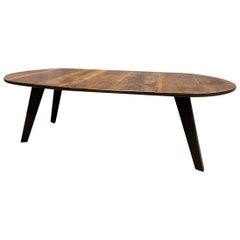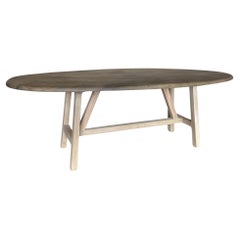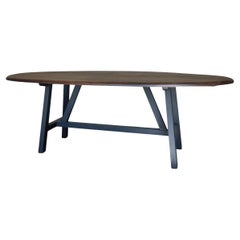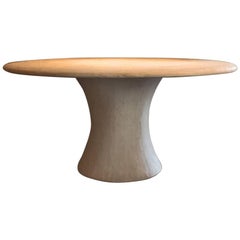Want more images or videos?
Request additional images or videos from the seller
1 of 14
Oval Table nor Model
$3,825.12List Price
About the Item
- Dimensions:Height: 29.9 in (75.95 cm)Width: 39 in (99.06 cm)Depth: 62.6 in (159.01 cm)
- Materials and Techniques:Beech,Bleached
- Place of Origin:
- Period:
- Date of Manufacture:Contemporary
- Production Type:New & Custom(One of a Kind)
- Estimated Production Time:Available Now
- Condition:
- Seller Location:Vosselaar, BE
- Reference Number:1stDibs: LU2023310028871
About the Seller
5.0
Gold Seller
Premium sellers maintaining a 4.3+ rating and 24-hour response times
Established in 1972
1stDibs seller since 2016
284 sales on 1stDibs
Typical response time: 7 hours
Authenticity Guarantee
In the unlikely event there’s an issue with an item’s authenticity, contact us within 1 year for a full refund. DetailsMoney-Back Guarantee
If your item is not as described, is damaged in transit, or does not arrive, contact us within 7 days for a full refund. Details24-Hour Cancellation
You have a 24-hour grace period in which to reconsider your purchase, with no questions asked.Vetted Professional Sellers
Our world-class sellers must adhere to strict standards for service and quality, maintaining the integrity of our listings.Price-Match Guarantee
If you find that a seller listed the same item for a lower price elsewhere, we’ll match it.Trusted Global Delivery
Our best-in-class carrier network provides specialized shipping options worldwide, including custom delivery.You May Also Like
Oval Teak Dining Table/ Desk Colonial
Located in Vancouver, British Columbia
Colonial teak oval dining table/desk. Circa 1890's.
Solid teak Colonial table uncompromisingly constructed from old growth wood with long flowing grain...
Category
Antique 1890s Dining Room Tables
Materials
Teak
Italian Neoclassic Oval Walnut Dining Table
Located in Dallas, TX
Amazing Italian neoclassic oval walnut dining table, recalling the glory days of ancient Greek and Roman civilizations, this stunning dining t...
Category
Mid-20th Century Italian Neoclassical Dining Room Tables
Materials
Walnut
1950's George Nelson X-Leg Extension Dining Table Model 5062
By Herman Miller, George Nelson
Located in Hanover, MA
Early George Nelson model 5062 X-Leg extension dining table for Herman Miller, 1952.
Table has two 12 inch extension leaves and pull-out metal extension tracks.
Table is 29 inches...
Category
Vintage 1950s American Mid-Century Modern Dining Room Tables
Materials
Iron
Pebble Edge English Walnut Dining oval Table by Jonathan Field
By Jonathan Field
Located in London, GB
The Pebble Edge Oval Table on Chapel Legs:
The pebble edge refers to the tabletop edge, which takes inspiration from the perfect skimming stone, a stone that has been smoothed and made tactile by natural forces. The photographs show it with the Carol Bentwood walnut chairs.
The two pieces of English walnut used for the top are joined centrally along the live edge and held in place with butterfly ties on the underside.
The tabletop stands...
Category
2010s English Modern Dining Room Tables
Materials
Walnut
$26,704 / item
H 29.5 in W 132 in D 48 in
Franco Albini Mahogany mid-centry Italian Table Model TL-22 produced by Poggi
By Franco Albini
Located in Barcelona, ES
Franco Albini & Franca Helg.
Dining table model no. TL22.
Manufactured by Poggi,
Italy, 1958.
Mahogany.
Measurements:
180.3 cm x 104.1 cm x 73 H cm.
70.98 in x 40.98 in x 28.74 in.
Literature:
Giuliana Gramigna, Repertorio 1950/1980, Milan, 1985, p. 123.
Franco Albini, was born in 1905 and died in 1977. He spent his childhood and part of his youth in Robbiate in Brianza, where he was born. Albini, as an adolescent moved with his family to Milan. Here he enrolled in the Faculty of Architecture of the Polytechnic and graduated in 1929. He started his professional activity in the studio of Gio Ponti and Emilio Lancia, with whom he collaborated for three years. At the 1929 International Exhibition in Barcelona (where Gio Ponti curated the Italian pavilion and Mies van der Rohe realized that of Germany) and in Paris where, as Franca Helg recounted, he had the opportunity to visit the studio by Le Corbusier.
In those three years, the works he carried out are admittedly of the twentieth century imprint. It is the meeting with Edoardo Persico that marked a clear turning point towards rationalism and the approach to the group of editors of "Casabella". The partly ironic and partly very harsh comments of the Neapolitan critic to a series of drawings, made by Albini for the design of some office furniture, caused him a great disturbance. “I spent days of real anguish - Albini recalls - I had to answer all the questions. I also had a fever, a large and long fever. "
The meted provoked Albini to openen a professional studio in via Panizza with Renato Camus and Giancarlo Palanti. The group of architects began to deal with public housing by participating in the competition for the Baracca district in San Siro in 1932 and then building the IFACP neighborhoods: Fabio Filzi (1936/38), Gabriele D'Annunzio and Ettore Ponti (1939).
During this period, Albini also worked on his first villa (Pestarini), which Giuseppe Pagano, architect and critic of the time, presented as follows: “This coherence, which the superficial rhetoric of fashionable jugglers calls intransigence, and which is instead the basis of understood between the fantasy of art and the reality of the craft, in Franco Albini, it is so rooted that it transforms theory into a moral attitude ".
But it is above all in the context of the exhibitions that the Milanese master experienced his compromise between that "rigor and poetic fantasy" of which Pagano speaks, coining the elements that became a recurring theme in his . The opening in 1933 of the new Triennale headquarters in Milan, in the Palazzo dell'Arte, was an important opportunity to express the strong innovative character of rationalist thinking, a gym in which to freely experiment with new materials and new solutions, but above all a "method". "Cultivated as a communication laboratory, the art of setting up was for the rationalists of the first generation what the perspective had been for the architects of humanism: the field open to a hypothesis of space that needed profound reflections before landing the concreteness of the construction site ".
Together with Giancarlo Palanti, Albini on the occasion of the V Triennale di Milano set up the steel structure house (with R. Camus, G. Mazzoleni, G. Minoletti and with the coordination of G. Pagano), for which he also designed the 'furniture. At the following Triennale of 1936, Persico dided, together with a group of young designers gathered by Pagano in the previous edition of 1933, Franco Albini took care of the preparations of the home exhibition. The setting up of Stanza per un uomo, at that same Triennale, allows us to understand the acute and ironic approach of Albini, as a man and as a designer: "Celebrating the beauty of mechanics was the imperative to which, for example, the surprising displays by Franco Albini who managed, in the subtle way of a refined and rarefied style, to sublimate their practical content in the metaphysics of daring still lifes: flying objects which marked in the void refined frames and metal intricacies the nodes of a fantastic cartography where industry finally became art free from purpose ".
That same year Albini and Romano designed the exhibition of the Ancient Italian Goldsmithery: vertical uprights, simple linear rods, designed the space. A theme, of the "flagpole", seemed to be the center of the evolution of production and the creative process. The concept is reworked over time, with the technique of decomposition and recomposition typical of Albinian design: in the preparation of the Scipione Exhibition and contemporary drawings (1941) the tapered flagpoles, on which the paintings and display cases were hung, are supported by a grid of steel cables; in the Vanzetti stand (1942) they take the V-shape; in the Olivetti shop in Paris (1956) the polished mahogany uprights support the shelves for the display of typewriters and calculators.
The flagpole is found, however, also in other areas. In the apartments he designed, it is used as a pivot on which the paintings can be suspended and rotated to allow different points of view, but at the same time as an element capable of dividing the spaces. The Veliero bookcase...
Category
Mid-20th Century Italian Mid-Century Modern Dining Room Tables
Materials
Mahogany
$11,162
H 28.75 in W 40.95 in D 70.87 in
Doris Oval Double Pedestal Dining Table in Green Marble and Cast Aluminum
By Fred&Juul
Located in Fiesole, Florence
Dining tables with marble tops and multifaceted pedestals in cast bronze, blackened bronze or aluminum.
Inspired by Doric columns in archaic architecture, the extruded multi-point star pedestals have a different finish on each vertical face: the cast metal is polished on one side but left raw on the other. The shading is amplified by the different finishes resulting in a dramatic effect. The pedestal(s) can be combined with tops in any kind of marble and with any shape or dimension. Crafted in Tuscany, Italy, in a foundry specialized in bronze sculptures, serving artists among the most renowned in the world.
These pieces are part of our Doris collection that also comprises a console, side and coffee tables.
Standard top materials: pink Portugal, white Carrara, green Serpentino and gold Calacatta marble.
Standard pedestal materials: oxidized bronze, blackened bronze and aluminum (polished and coarse).
Standard sizes:
round top 5'3" diameter (seats 8)
oval top 3'7" x 6'7" (seats 8)
rectangular top 3'11” x 7'11” (seats 10)
top thickness 0.8"
single pedestal 25.2" diameter
double pedestal 14.2" diameter each
This listing is for a double pedestal oval table...
Category
2010s Italian Modern Dining Room Tables
Materials
Marble, Breccia Marble, Carrara Marble, Siena Marble, Aluminum, Bronze
$30,961 / item
H 29.53 in W 78.75 in D 43.31 in
Doris Oval Double Pedestal Dining Table in Green Marble and Blackened Bronze
By Fred&Juul
Located in Fiesole, Florence
Dining tables with marble tops and multifaceted pedestals in cast bronze, blackened bronze or aluminum.
Inspired by Doric columns in archaic architecture, the extruded multi-point star pedestals have a different finish on each vertical face: the cast metal is polished on one side but left raw on the other. The shading is amplified by the different finishes resulting in a dramatic effect. The pedestal(s) can be combined with tops in any kind of marble and with any shape or dimension. Crafted in Tuscany, Italy, in a foundry specialized in bronze sculptures, serving artists among the most renowned in the world.
These pieces are part of our Doris collection that also comprises a console, side and coffee tables.
Standard top materials: pink Portugal, white Carrara, green Serpentino and gold Calacatta marble.
Standard pedestal materials: oxidized bronze, blackened bronze and aluminum (polished and coarse).
Standard sizes:
round top 5'3" diameter (seats 8)
oval top 3'7" x 6'7" (seats 8)
rectangular top 3'11” x 7'11” (seats 10)
top thickness 0.8"
single pedestal 25.2" diameter
double pedestal 14.2" diameter each
This listing is for a double pedestal oval table...
Category
2010s Italian Modern Dining Room Tables
Materials
Marble, Breccia Marble, Carrara Marble, Siena Marble, Aluminum, Bronze
$33,896 / item
H 29.53 in W 78.75 in D 43.31 in
Hans J. Wegner Drop Leaf Desk or Table Model "AT-305" for Andreas Tuck, 1955
By Hans J. Wegner, Andreas Tuck
Located in Odense, DK
This magnificent drop-leaf table by Danish designer Hans J. Wegner can be used both as a work desk and as a dining table. The design is from 1955 and this particular table is from th...
Category
Vintage 1960s Danish Scandinavian Modern Desks and Writing Tables
Materials
Oak, Teak
$9,987
H 28.75 in W 55.12 in D 29.93 in
Vintage Plate Glass and Chrome Dining Table Model 6060 by Leon Rosen for Pace
By Leon Rosen, Pace Collection
Located in Brooklyn, NY
Stylish and sophisticated dining table (model 6060) designed by Leon Rosen for the Pace Collection composed of a heavy plate-glass 72" long top supported by two chrome and plate-glas...
Category
Vintage 1970s American Mid-Century Modern Dining Room Tables
Materials
Chrome
$6,500
H 29.25 in W 72 in D 44 in
Mid-Century Modern Oval Dining Table or Desk by Florence Knoll in Carrara Marble
By Florence Knoll, Knoll
Located in Philadelphia, PA
An elegant executive table designed by Florence Knoll and produced by Knoll. It features a beautiful polished white & gray Carrara marble top and a chrome-plated star base. This was ...
Category
1990s American Mid-Century Modern Dining Room Tables
Materials
Marble, Chrome
$6,500
H 27.5 in W 78 in D 47.75 in
More From This Seller
View AllCustom Made Table Old Walnut and Burned Oak
Located in Vosselaar, BE
Ou custom made dining table BIL. Inspired by modernist design we combined 18th century Italian walnut with burned oak supports. Please note that the materia...
Category
2010s Belgian Dining Room Tables
Materials
Walnut
Custom walnut 2 plank top oval dining table Model LUSI
Located in Vosselaar, BE
Our LUSI dining table is based on 17th and 18th century mountain trestle tables. The trestle base is manually assembled and proportioned following the golden cut. The 2 plank top is ...
Category
2010s Dining Room Tables
Materials
Oak, Walnut
Custom walnut 2 plank top oval dining table Model LUSI dark finish
Located in Vosselaar, BE
Our LUSI dining table is based on 17th and 18th century mountain trestle tables. The trestle base is manually assembled and proportioned following the golden cut. The 2 plank top is ...
Category
2010s Dining Room Tables
Materials
Oak, Walnut
Oval Table Su in Petrified Marbleplaster
Located in Vosselaar, BE
As we value craftmanship and creativity more than everything we are always searching for timeless designs. Sometimes we also have a go at it ourselves and each time follow the same p...
Category
2010s Belgian Dining Room Tables
Materials
Plaster
$11,456 / item
Oval Table SOFIA in Petrified Marbleplaster
Located in Vosselaar, BE
Our SOFIA table was inspired by Classic design and proportions. We purified the idea of a ionic colomn and designed a table around it. The used material is a marbleplaster which petr...
Category
2010s Belgian Dining Room Tables
Materials
Plaster
$10,592 / item
Walnut Top Iron Table
Located in Vosselaar, BE
A small writing or side table with a 18th century Italian walnut top on a custom made iron base. The top is one piece of walnut with great color and patina.
Category
21st Century and Contemporary Italian Desks and Writing Tables
Materials
Walnut
$2,353
Recently Viewed
View AllMore Ways To Browse
Oval Belgian Table
Belgian Oval Dining Table
Oval Bleached Table
Granite Round
Solid Wood Pedestals
Teak Drop Leaf Table
Victorian 19th Century Extendable Table
Vintage Butterfly Table
Antique English Pedestal Table
Draw Leaf Table
Flip Top Dining Table
Italian Trestle Table
Knoll Tulip Dining
Olive Dining Wood Tables
Eero Saarinen Marble Table
Retro Flip Top Table
Skirted Table
Wood Parsons Table



